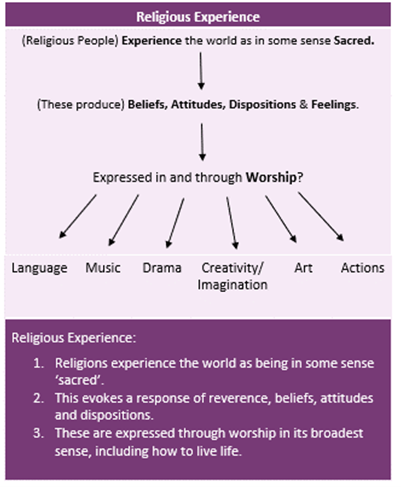Appendix 4 - Conceptual Creativity
Last updated:Central to the approach to learning in the Buckinghamshire Agreed Syllabus is the process of building bridges between the pupils’ own lives and the religious content that they explore. Whether the pupil comes from a particular faith background or none, RE must be relevant to their lives and engage them in meaningful learning with which they can identify and that they can apply to life.
In order to provide opportunities for all children to learn and grow through their Religious Education, we have to take their own experience seriously whilst expanding their knowledge, understanding and horizons through the religions and worldviews. In this way they can appreciate the significance of the beliefs, practices and lifestyles found in the principal faiths and worldviews, to life in the modern world and to their own lives. RE moves pupils beyond their own worldview to explore other worldviews and ways of living found in the principal religions and beliefs of humanity – ‘the best which has been thought and said in the world’ – and bringing this to bear on their own worldview and way of living. Pupils are challenged to think reflectively and critically about what they learn, through an exploration of key questions and concepts.
The diagrams on the following pages provide a structure to help plan for this.
The ‘universal’ structure on the left of the diagram provides a way of exploring the pupils’ own experiences, ideas and feelings: We all have experiences.
- These experiences evoke a range of responses (feeling, thinking, challenging).
- We need to express these responses and make sense of them and do so in a variety of ways.
The ‘religious’ structure on the right of the diagram mirrors the universal structure, but in the context of a faith perspectives: Religions experience the world as being in some sense ‘sacred’.
- This evokes such responses as reverence and particular beliefs, attitudes and dispositions.
- These are expressed through worship in its broadest sense, including how to live life.
People use a range of ways of expressing these feelings, thoughts and challenges, whether secular or religious: art, music, drama, language, inner creativity and imagination, actions and the way we live our lives; and these can combine in various ways (e.g. words and music = songs).
High quality RE is challenging, engaging and transformative because it engages pupils with the big questions and concepts that help them to make sense of experience and what it means to be human.



We can now build bridges between the pupils’ own experiences and the faith experiences of others through an exploration of questions and concepts. These bridges can start anywhere on the diagram (e.g., music to personal feelings to personal experience and over to religious worship, on to religious belief, feeling or attitude and reflection on relevant concepts and questions) and pupils can engage in creative ways to understand both their own experiences and other people’s. However, it is the creative conceptual enquiry that provides the link between the two and which has to occur for there to be any meaningful learning and connection. This produces engaging, creative, challenging, enjoyable and worthwhile Religious Education, in which pupils genuinely learn and grow.
Model of Conceptual Creativity

